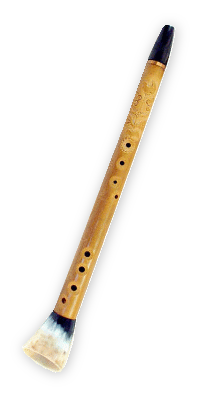BirbynÄ—
The Birbynė is a Lithuanian wind instrument whose sound is produced by a single-reed. The Birbynė was developed in the 20th century from a diatonic horn whistle to a fully chromatic instrument. There are instruments of varying size for soprano, tenor and contrabass. In addition to the Kankles it applies in Lithuania as a national instrument. Instrumentenkundlich it is related to the Chalumeau, the Tárogató and the clarinet.
Various vocal ranges
The most frequently (even solo ) used form is the Sopranbirbynė. She has a tube made of wood ( usually maple or apple wood). The inner bore is partly cylindrical, conical part. Using a speaker key, the Birbynė überbläßt in the tenth small, ie when a tone is heard just about blow c '. The range of the Sopranbirbynė may take up to two and a half octaves are ( from a to c'' ' ). It has ten finger holes, eight of them on the top and two thumb holes on the bottom. The reed is attached to a mouthpiece similar to the clarinet mouthpiece and is made of ebony or horn. At the end of the sound tube sits a resonance funnel from cow horn. The gripped with the right hand lower handle holes give a chromatic scale. The holes that are gripped with the left hand, are in full and the usual semitone C-major scale. In this area increased or decreased tones are generated by auxiliary handles. The Sopranbirbynė sound in the lower register soft and warm with hints of the saxophone in high bit sharper with notes of the oboe.
The Tenorbirbynė similar to the Sopranbirbynė, but is longer. For ease of playability some flaps are used. Its scope ranges from H - c''. Their strong and full sound is often compared to the cello.
The sound tube of Contrabassbirbynė is painted brass and wood color. Your mouthpiece is angled, the horn is a large horn or imitation horn. The scope ranges from Fis1 to c '. In the lower register it sounds counterproductive fagott similar in the high clarinet way.
Development of the instrument
The term is Birbynė 1747 is literary for the first time ( Ruigys ). She was originally a generic term for reed instruments of different types and included Strohhalmchalumeaux, whistling with goose feather leaf, pipe pipes from various types of wood and even a goat's horn with a reed mouthpiece.
Today's Birbynė emerged called horn whistle from a Ragelis ( " little horn "). This was 25-30 cm long, with 5-7 finger holes; only the lower octave had a pleasant sound. By the end of the 19th century. it has been used in folk music, but then increasingly replaced by clarinet and accordion, so it. in the 30s and 40s of the 20th century was almost forgotten.
As part of the revival instruments have been created in different vocal ranges to meet the needs of the folklore ensembles to better correspond (in C, D and G, as well as a bass and a bass instrument). To play new Lithuanian compositions with chromaticism and modulation, the instrument maker Serva and the People's Ensemble conductor Samuitis developed the present form of high Birbynė. The deeper instruments have been amended accordingly.
The Birbynė is played solo or in an ensemble with other Lithuanian folk instruments today. A Birbynė quintet often consists of two sopranos, two tenor and one Kontrabassbirbynė. The repertoire includes not only folklore and other light music. On the Birbynė classical solo works for clarinet or other wind instruments being played.









